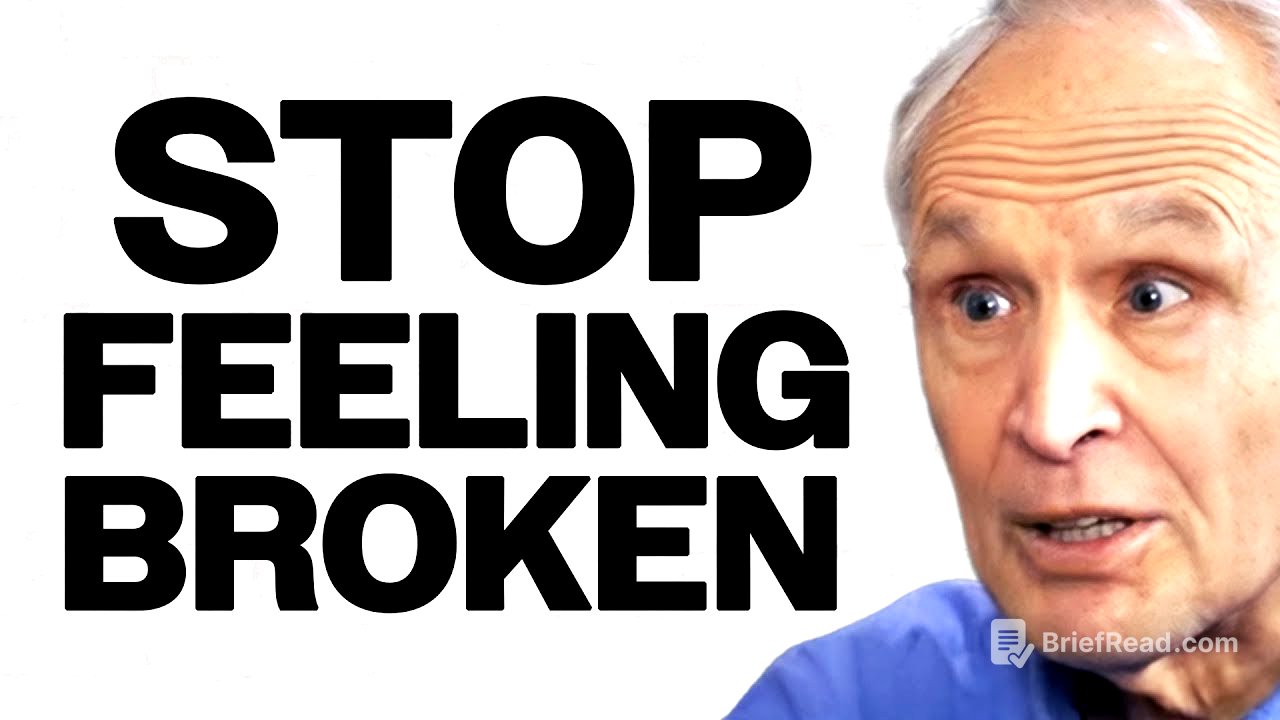TLDR;
Peter Levine discusses trauma, somatic therapy, and the body's role in healing. He defines trauma broadly, not just as PTSD, but as any experience that injures the soul and limits life force. Somatic therapy addresses trauma by focusing on the body's physical responses and changing the feedback loop between the gut and the brain. He emphasizes that trauma doesn't have to be a life sentence and can be transformed with the right tools.
- Trauma is not just PTSD but any wounding experience that limits life.
- Somatic therapy focuses on the body's physical responses to trauma.
- The vagus nerve plays a crucial role in the feedback loop between the gut and the brain.
- Trauma can be healed by addressing physical symptoms and creating new body experiences.
- Everyone has the capacity to heal their own wounds and tell their own story.
Defining Trauma [0:00]
Peter Levine defines trauma as any wound or injury to the soul that limits one's life force or expression, broader than just PTSD. He shares a personal story of being interrogated and hit by his parents as a child after taking a buzzer from his cousin's warehouse, leading to a feeling of betrayal and a sense that the world is not safe. He also mentions a client who was yelled at for pulling a tablecloth, causing everything to crash. These experiences, though not PTSD, can be deeply wounding. Levine emphasizes that trauma doesn't have to be a life sentence and can be overcome. He acknowledges the distinction between "big T" and "little t" trauma, noting that deeply traumatized individuals may scatter, fragment, dissociate, and need help to recover.
Why Somatic Therapy is Unique [4:22]
Peter Levine explains that somatic therapy differs from traditional trauma therapy by addressing the body's physical responses to trauma. He recounts how, early in his career, he observed that witnessing a horrible event, like a child being hit by a car, causes physical reactions such as gut twisting, breath-holding, and heart rate acceleration. These physical responses signal danger to the brain. The vagus nerve, the largest nerve in the body, plays a crucial role, relaying information from the guts, heart, and lungs back to the brain, amplifying the body's response to threat. Chronic threat exposure can lead to conditions like irritable bowel syndrome. Somatic therapy aims to change the information flow from the gut to the brain, accessing and altering bodily sensations to promote healing.
How Somatic Experiences Calm You [11:55]
Peter Levine guides through an exercise to change the information coming from the gut to the brain, promoting a sense of safety and goodness. The exercise involves taking an easy, full breath and exhaling with the sound "Vu," vibrating the receptors in the gut. This sends a signal through the vagus nerve to the brain stem, indicating that everything is okay. Following the exercise, individuals are encouraged to scan their body, noticing sensations, feelings, thoughts, and images. This practice aims to create a positive feedback loop, contrasting with the negative consequences of trauma. Additionally, Levine suggests a top-down approach by consciously noting when one feels relaxed and repeating the phrase, "I give myself this gift of deep inner relaxation," to further enhance the calming effect.
When Charles Discovered These Ideas [15:40]
Peter Levine recounts discovering the principles of somatic experiencing in the 1960s while working with men with high blood pressure. Relaxation exercises lowered their blood pressure and triggered the emergence of sensations, feelings, and memories, including traumatic childhood experiences. He mentions Vincent Fetti's ACE study, which links childhood trauma to increased risks of anxiety, depression, and metabolic illnesses. Levine notes that medical trauma, falls, and accidents should also be considered. He emphasizes the importance of therapists addressing their own wounds to be available to their clients.
How Much Attention Should We Pay to Our Dreams? [21:54]
Peter Levine emphasizes the importance of paying attention to dreams, not just the content but also the feelings they evoke. He shares a dream from the early 1980s involving a Tibetan llama who hands him a wooden box, instructing him to place it in a safe. Levine interprets this dream as a directive to integrate spiritual knowledge with Western science and medicine, making it more accessible. He sees his work in developing somatic experiencing as fulfilling this task.
When Albert Einstein Appeared in Peter’s Dreams [26:01]
Peter Levine recounts his experience of Albert Einstein appearing to him in dreams while working on his thesis at Berkeley. He describes these encounters as a form of active imagination, where he would meet Einstein at a restaurant and discuss various topics, particularly the traumas and wisdom passed down from ancestors. These conversations guided Levine in understanding how energy patterns continue through time. Later, Levine discovered that his parents were saved from a canoeing accident by Albert Einstein and his stepdaughter, reinforcing the significance of Einstein as a guiding figure in his life.
The Importance of Feeling Loved in Overcoming Trauma [32:33]
Peter Levine discusses the importance of feeling loved in overcoming trauma. He shares a personal story of being violently raped by the Mafia at age 13 to prevent his parents from testifying against them. He contrasts this traumatic memory with a positive one from his childhood when his parents set up a train set around his bed on his birthday, filling him with a sense of being cared for and loved. Levine emphasizes that even one instance of feeling loved can provide the resilience needed to cope with trauma. He worked through his trauma with a student, highlighting that trauma doesn't have to be a life sentence with the right tools.
Similarities With Polyvagal Theory [40:44]
Peter Levine clarifies that he developed his work before knowing about Stephen Porges' Polyvagal Theory, though they have been colleagues and close friends for many years. He recognized the Polyvagal Theory as a valuable model for psychotherapy, especially trauma therapy. Levine notes the phenomenon of simultaneous invention, where similar ideas arise independently, suggesting the time is right for such concepts.
Key Tools to Heal Trauma [42:38]
Peter Levine outlines key principles for healing trauma: trauma is trauma, regardless of the event, and it's not about what happened but what happened in the absence of a present, empathetic, caring other. He emphasizes guiding people gently through somatic experiencing, avoiding re-traumatization. He advocates for titrating, touching into sensations without overwhelming the nervous system. The goal is to provide tools for trauma that enable individuals to find peace with their experiences.
Physical Manifestations of Trauma [49:35]
Peter Levine explains that psychological trauma manifests physically with symptoms varying for each person. Somatic therapy addresses these physical symptoms rather than focusing solely on remembering or thinking about the trauma. He references Bessel van der Kolk's description of him as a pioneer in understanding and dealing with the physical imprints of traumatic stress. Levine shares a story of working with a war veteran diagnosed with multiple conditions, including Tourette's syndrome. Levine recognized the veteran's movements as attempts to localize the source of the threat from IED explosions. By working with these movements in a titrated manner, the veteran experienced relief and a significant reduction in convulsions.
Misconceptions of Somatic Therapy [58:37]
Peter Levine addresses misconceptions about somatic therapy, particularly the fear that too much can happen if one feels their body. He emphasizes that gradual guidance and titrated exposure prevent overwhelming the individual. He notes that traumatized individuals may fear any change, even positive sensations, and block their access to healing. He uses the example of sexually traumatized women experiencing painful intercourse, highlighting the need for new body experiences that contradict feelings of helplessness. Levine underscores the importance of opening up to one's sexuality in a safe way and working through body memories.
Integrating Somatic Therapy in Daily Life [1:05:30]
Peter Levine suggests integrating somatic therapy techniques into daily life by noticing and deconstructing fear. Fear consists of body sensations, thoughts, and images. He recommends acknowledging negative thoughts by prefacing them with "I have the thought that" to recognize them as just thoughts. By separating sensations, feelings, thoughts, and images, individuals can move through them more effectively.
Peter’s Thoughts on Hypnosis [1:09:50]
Peter Levine discusses the relationship between somatic experiencing and hypnosis, noting overlaps with Ericksonian hypnosis. He suggests that any approach supporting a person's healing capacity can be enhanced by somatic experiencing.
Where to Find Peter [1:11:02]
Peter Levine provides resources for those interested in exploring somatic therapy further, including his website, somaticexperiencing.com, which links to his nonprofit organization. The website lists trainings and therapists in various countries. He also mentions traumahhealing.org, an organization supporting trauma healing. He believes everyone can benefit from this type of therapy, especially those who don't think they can.
Living a Genius Life [1:14:55]
Peter Levine reflects on what it means to live a genius life, recalling an interview where he was called a prophet. He acknowledges himself as a visionary and esteemed teacher, drawing parallels to Kahlil Gibran's "The Prophet." Levine believes everyone has the potential for visionary thinking and that these visions are worth knowing and sharing. He emphasizes that genius is built, not just born, and resides within everyone.









